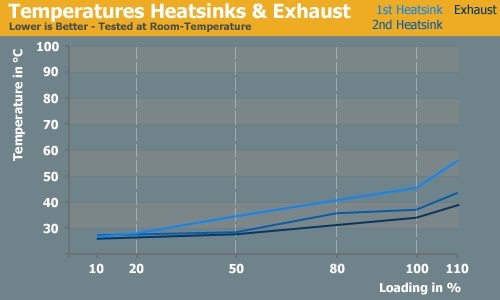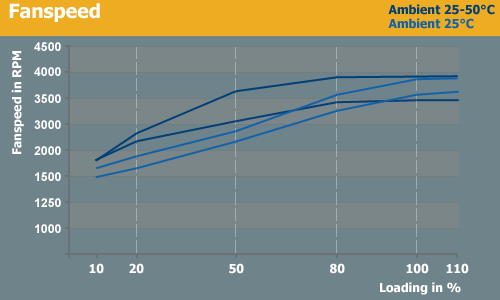Ultra High-End PSU Roundup
by Christoph Katzer on October 22, 2007 6:00 AM EST- Posted in
- Cases/Cooling/PSUs
Tagan ITZ 1300W Efficiency, Temperatures, Fan Speed and Acoustics

The efficiency is similar to what we have seen from the other two power supplies. The difference we can see here is the nicely even curve which is constantly above 80% with any load above 260W, with a slight drop near the 100% load mark.


The temperatures increase slowly during room temperature testing which is a good sign for a well arranged airflow. Just with overload the temperature is suddenly making a big step of over 10°C within a few minutes. Under the hotter heat chamber conditions the temperature begins to increase at medium load and beyond. Naturally, the fans are also spinning faster at this point, but they are nearing their limit. The temperature of both heat sinks mostly stabilizes by 80% load, beyond which point heat is only increasing slowly.


The push-pull fan configuration is quite effective, and having a more powerful fan on the exhaust also works quite well. In this way there is a kind of vacuum established which lets air come in through the venting holes on the side. The result is that the components are cooler but this kind of power supply still gets very hot and needs proper airflow to function. This can only be done with high speed fans, and with up to 4000 RPM this might be enough. Also with this power supply we see the full speed already reached at half of the full load while in the heat chamber. Under room temperature conditions the fan is steadily spinning faster and only reaches maximum RPM at full load. It's again clear that the amount of airflow necessary to cool a 1300W power supply cannot be achieved without producing noise, and therefore we see up to 45dB(A) under hot conditions. With low speeds at lower loads you can still hear the fan quite easily, but in a PC system this noise will not be as audible as when we had it open and running in front of us.

The efficiency is similar to what we have seen from the other two power supplies. The difference we can see here is the nicely even curve which is constantly above 80% with any load above 260W, with a slight drop near the 100% load mark.


The temperatures increase slowly during room temperature testing which is a good sign for a well arranged airflow. Just with overload the temperature is suddenly making a big step of over 10°C within a few minutes. Under the hotter heat chamber conditions the temperature begins to increase at medium load and beyond. Naturally, the fans are also spinning faster at this point, but they are nearing their limit. The temperature of both heat sinks mostly stabilizes by 80% load, beyond which point heat is only increasing slowly.


The push-pull fan configuration is quite effective, and having a more powerful fan on the exhaust also works quite well. In this way there is a kind of vacuum established which lets air come in through the venting holes on the side. The result is that the components are cooler but this kind of power supply still gets very hot and needs proper airflow to function. This can only be done with high speed fans, and with up to 4000 RPM this might be enough. Also with this power supply we see the full speed already reached at half of the full load while in the heat chamber. Under room temperature conditions the fan is steadily spinning faster and only reaches maximum RPM at full load. It's again clear that the amount of airflow necessary to cool a 1300W power supply cannot be achieved without producing noise, and therefore we see up to 45dB(A) under hot conditions. With low speeds at lower loads you can still hear the fan quite easily, but in a PC system this noise will not be as audible as when we had it open and running in front of us.










27 Comments
View All Comments
alilxmas - Sunday, May 10, 2009 - link
At the end the reviewer had no personal preference, kinda left it off in mid sentence there... at least to me.Anyway some people do have to get the latest and do need a i7 CPU, multiple GPU's, slight OC, 6 hard drives, 3 monitors, etc.
Heres some things I do besides gaming,
Encoding videos from about 6-8 hours a day recorded footage sent from people who drop off anything from their safari trip to a wedding converted to dvd, formatted for their DSi or i-touch.
Processing RAW files (about 20mb per pic)
3-D Animation and models
Also for the air problem a slight mod can fix almost anything.
alilxmas - Sunday, May 10, 2009 - link
At the end the reviewer had no personal preference, kinda left it off in mid sentence there... at least to me.Anyway some people do have to get the latest and do need a i7 CPU, multiple GPU's, slight OC, 6 hard drives, 3 monitors, etc.
Heres some things I do besides gaming,
Encoding videos from about 6-8 hours a day recorded footage sent from people who drop off anything from their safari trip to converted to dvd, formatted for their DSi or i-touch.
Processing RAW files
3-D Animation and models
Also for the air problem a slight mod can fix almost anything.
Christoph Katzer - Tuesday, November 6, 2007 - link
Housten: We have Ripple, please confirm we have Ripple... the world makes sense again!TheOtherRizzo - Tuesday, October 30, 2007 - link
The efficiency graphs don't start before 20%. 20% is 250W. That's a lot more than an average computer uses on idle. So the tests don't tell me what these "Hi end" PSU's will do to my power bill and heat/noise output.strikeback03 - Tuesday, October 30, 2007 - link
The "average computer" also does not need a 1200W+ PSU. Look at Jarred's power usage numbers from the Blackbird test (linked above) - used 370W at idle and 740 at load.Fallen Kell - Tuesday, October 23, 2007 - link
The power cord connection on the Cooler Master Real Power Pro is NOT proprietary! That is a standard IEC-320-C19/C20 power connector. It is typically used for high power draw situations, (i.e. like 208V 20amp circuits, not your standard home 110V 15amp). This is actually a good thing for use in this situation. At full load, and the 80% efficiency associated with it, this power supply will need 14amps on your standard 110V outlet. That is not something your standard home wiring and sockets are designed to do. Many will only be rated for 10-12 amps per socket, 15amps for the entire circuit! By using a different connector like this, it will force people to use the appropriate rated wire and sockets, because this beast will draw more power then that basic home wiring can dish out without melting down and becoming a fire hazard.strikeback03 - Tuesday, October 30, 2007 - link
Didn't mention if the wall connector is different. However using the different connector at the PSU will make it harder to use an inadequate power cable from wall to PSU. The Infiniti 650W PSUs we used in a few recent builds had larger-than-normal power cords, I would imagine a 1200W PSU needs a cable that is larger yet.JarredWalton - Tuesday, October 23, 2007 - link
Ummm... the socket on the back of the PSU is different. The main connector on the other end is still standard, AFAIK.Bozo Galora - Monday, October 22, 2007 - link
heres another review of the same PCP&C PSUhttp://www.pcper.com/article.php?aid=458&type=...">http://www.pcper.com/article.php?aid=458&type=...
here he gives volatges given at both at PSU and at ATX connector with a discussion about it.
No other in depth PSU reviews show the lowering degree of V with load that yours consistently do for some reason.
Christoph Katzer - Tuesday, October 23, 2007 - link
Just have a look at the loading diagram, I am testing strictly according to Intel specs and have ~20A on 3.3 and ~24A on 5V. There I see only ~16-17 amps on both. That the voltage regulation works better with less load should be quite clear. Compare the loads and not only voltage.